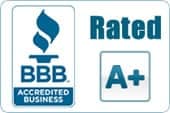The term “rooter service” was first coined as a method for clearing tree roots out of a sewer line. In modern day, it is used to describe all manner of drain cleaning. In this article we will cover both meanings of the phrase, and give you some things to look for to know if you are getting a proper “rooter service”.
Equipment
The first thing to look for, when getting any type of drain cleaning is the equipment the plumber will be using. The machine can make a huge difference in how well your line is cleared. As a rule, your plumber should always use the biggest cable that can be used safely. Here are some examples from small to large:
Tub drains and shower drains – These lines require small cables (1/4” diameter or equivalent) to be able to successfully navigate the p-trap. Also, since these fixtures are usually quite close to the main sewer line, a shorter, smaller diameter cable is ideal.
Kitchen and laundry drains – While it is okay to run a small cable through the laundry trap, they are not usually long enough to go much further than that, nor do they do a good job of cleaning these lines. For laundry and kitchen lines, a bigger machine with a larger cable (13/32” is a great cable size for these) should always be used. Whether or not to use a blade on the end of the cable can be at the plumbers discretion. Sometimes slowly cabling a line with a cable with a “gooch” at the end can do a better job of clearing grease blockages than a blade.
Sewer mains – These require the big boys. 11/16 cable or larger is recommended here, and there should ALWAYS be a blade on it. The reason is that the vast majority of sewer line blockages are caused by roots. You need a blade to cut through them. It can also be dangerous. When roots get into your sewer line, they create holes. If a drain cleaning cable exits one of those holes, it will bind up, and get stuck. Then you have no choice but to get the shovel out, and start digging up your sewer line. A blade help keep the cable in the line where it belongs. You ALWAYS want the proper sized blade for the line size.
A couple of things happen if you use the wrong equipment. First of all, if the cable is too small (like using a kitchen sink cable to clear a main line) the cable can double back on itself and get all twisted up in the pipe. Depending on how badly it gets twisted, it may be impossible to get it out without digging up the pipe.
The other problem is that even if that cable does not get stuck, the chances of getting a thorough cleaning are slim.
Access
The second thing you need to consider is the access point. Simply put, the plumber must be able to get the proper sized cable/blade into the pipe, and the access should be as direct as possible. Here is a couple of common scenarios where better access is needed when clearing a sewer main…
The first is the most common for us. We come to a house that has a 4” main line. There is no cleanout, and the customer is not ready to invest in one. The next best option is pulling a toilet, and cabling through the “closet bend”.
The first problem is that a closet bend often has a 3” fitting in there, and we need to clean a 4” pipe. Right there we are limited to the size of the blade we can use. The second problem is that, even using the biggest blade for a 3” pipe would be very difficult, due to the fact that there are at least 3 tight bends in the pipe, all in very close proximity to each other. At best, we can use a 2 1/2” blade.
The third problem is that we are much farther away from the blockage that we want to be. Close to the blockage is always better. Still, believe it or not, this method is second best to a cleanout.
Another scenario, and one that is seen far too often, is a plumber going on the roof. This is never a good thing. First off, the vent is usually only 2”, and even if it is 3” you are still a size too small. The second thing, is that now you are 10’ further away from the blockage. The third is that you do not want a plumber and a 150+lb machine on your roof, if he can even get it up there, so most people that clear drains from roof vents use smaller machines (which we discussed above).
Oh, and it also happens to be illegal, unsafe, bad for your roof, and can almost never be done properly. Do not agree to this method.
So, there you go… some of the things to look out for the next time you need a rooter service. When in doubt, just call Allstar Plumbing. At least then you know you will be getting the job done right.




